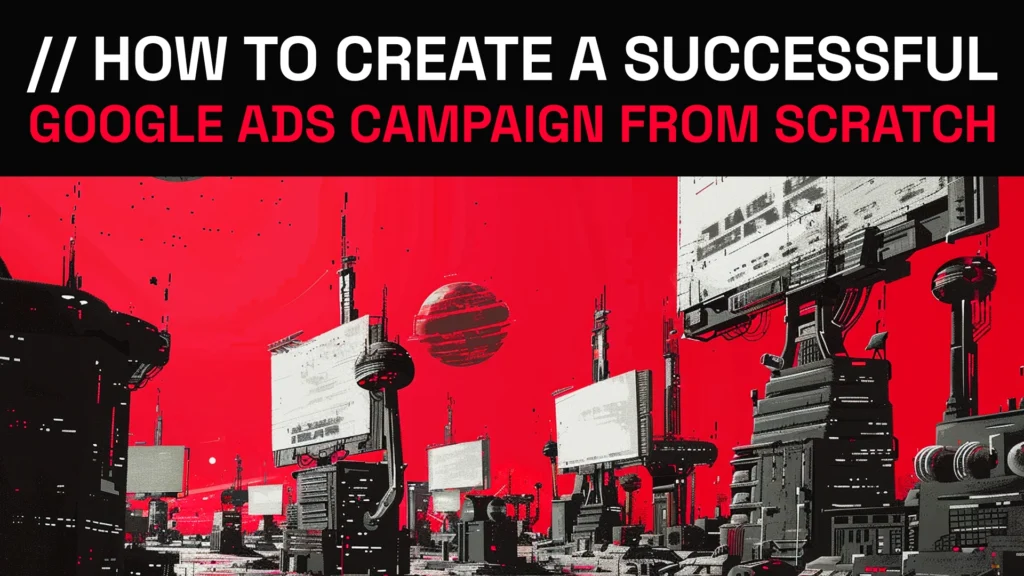TAKE YOUR BUSINESS TO THE NEXT LEVEL
Let us take marketing off your plate. Visit our pricing to learn more about working with Next Level.

Google Ads is a powerful platform that allows businesses to reach their target audience through paid search advertising. When done correctly, a Google Ads campaign can drive targeted traffic, increase conversions, and ultimately boost your bottom line. In this article, we will discuss the best practices for creating a successful Google Ads campaign from scratch.
Before launching a Google Ads campaign, it is crucial to define your goals and target audience. What do you want to achieve with your campaign? Are you looking to increase brand awareness, generate leads, or drive sales?
Once you have established your goals, identify your target audience. Consider factors such as age, gender, location, interests, and behaviors when defining your ideal customer. (Demographic information is a good start, but we think psychographics are more informative of your ideal customers’ tendencies)
Understanding your target audience will help you create ad copy and landing pages that resonate with them, increasing the likelihood of conversions. Use tools like Google Analytics and Facebook Audience Insights to gather data on your target audience and refine your targeting strategy.
Keyword research is the foundation of a successful Google Ads campaign.
Identify the keywords and phrases your target audience is using to search for products or services like yours.
Use tools like Google Keyword Planner, SEMrush, or Ahrefs to find relevant keywords and assess their search volume and competition level.

When selecting keywords, consider using long-tail keywords that are specific to your offerings. These keywords typically have lower search volume but higher conversion rates, as they indicate a more targeted search intent.
Additionally, consider using negative keywords to exclude irrelevant searches and improve the quality of your traffic.
Your ad copy and landing pages should be designed to capture the attention of your target audience and persuade them to take action. Write clear, concise, and engaging ad copy that highlights your unique value proposition and includes a strong call-to-action (CTA).
Ensure that your landing pages are relevant to your ad copy and provide a seamless user experience. Use persuasive elements like social proof, trust badges, and clear CTAs to encourage conversions. Optimize your landing pages for mobile devices, as a significant portion of Google Ads traffic comes from mobile users.
Organize your Google Ads campaign into a hierarchical structure of ad groups and ads. Each ad group should contain a set of closely related keywords and corresponding ads. This allows you to create highly targeted ad copy and landing pages that are relevant to the user’s search query.
Consider using Single Keyword Ad Groups (SKAGs) for your most important keywords. SKAGs allow you to create hyper-targeted ads and landing pages, leading to higher click-through rates (CTR) and conversion rates.

Determine your daily budget based on your overall marketing goals and the estimated cost-per-click (CPC) for your target keywords. Start with a conservative budget and adjust it over time based on the performance of your campaign.
Set your bids at the ad group level, considering factors like keyword competition and the expected value of a conversion.
Regularly monitor the performance of your Google Ads campaign using metrics like CTR, conversion rate, and cost-per-acquisition (CPA). Use this data to identify areas for improvement and make data-driven decisions.
Continuously test and optimize various elements of your campaign, such as ad copy, landing pages, and targeting settings. Use A/B testing to compare the performance of different variations and iterate based on the results. Stay up-to-date with the latest best practices and industry trends to ensure your campaign remains competitive.
Creating a successful Google Ads campaign requires a strategic and data-driven approach. By defining clear goals and target audience, conducting thorough keyword research, creating compelling ad copy and landing pages, structuring your campaign effectively, setting appropriate budgets and bids, and continuously monitoring and optimizing your performance, you can maximize the impact of your advertising efforts and achieve your business objectives.
Remember that a successful Google Ads campaign is an ongoing process, not a one-time event. By staying committed to continuous improvement and adapting to the fast paced world of online advertising, you can create a sustainable and profitable advertising strategy that drives long-term growth for your business.
Let us take marketing off your plate. Visit our pricing to learn more about working with Next Level.